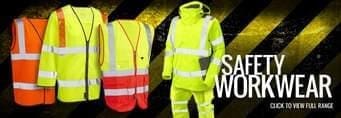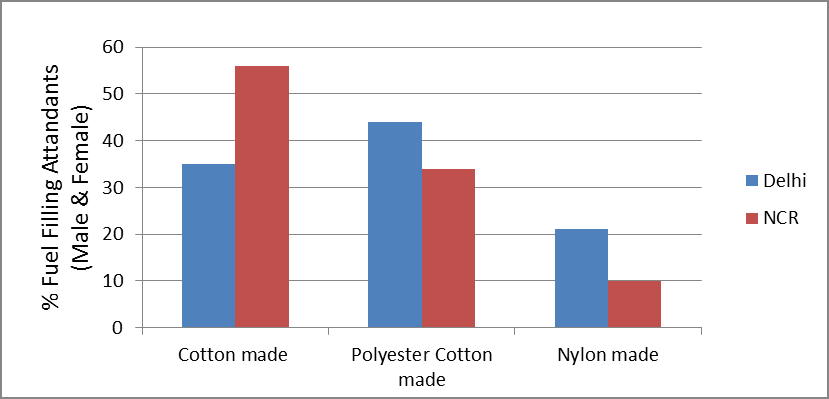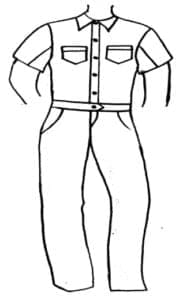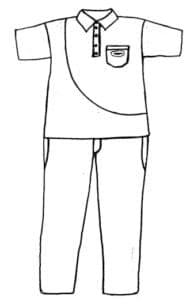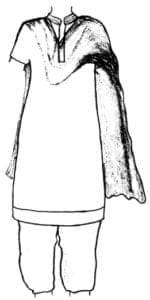Safety work-wears for oil and gas fuel filling station attendants
M.S.Parmar, Noopur Sonee*, Shweta Saxena and Chitra Arora*
Northern India Textile Research Association, Sector-23, Rajnagar, Ghaziabad
*Institute of Home Economics, Delhi University4
1.0 Introduction
Workers are routinely exposed to potentially harmful situations or hazards in industries- especially in manufacturing, petrochemicals and construction. These hazards may be physical such as fire, fluctuating temperature, flying sparks, electrical, moving objects or sharp edges. They may also be health related such as exposure to radiant heat, loud noise, harmful dusts, chemicals or viruses. These hazards are responsible for wide range of injuries and illness starting from a simple headache to severe burns and respiratory diseases. According to International Labour Organization (ILO), more than 2 mn people worldwide die of work related accidents and diseases every year; this corresponds to over 6000 deaths every single day. Worldwide, there are around 340 million occupational accidents and 160 million victims of work-related illnesses annually. (1) The death toll is higher in developing countries than in developed countries. These lives may be saved if they are provided with right types of protective work-wear that suits the prevailing working conditions (2).
Oil & Gas fuel filling stations are particularly hazardous workplaces which require safety of petrol attendants because they store and sell a highly flammable liquid. As the fuel handled by these filling stations is highly flammable in nature, it becomes one of the riskiest places for fuel pump attendants for their health and safety. Petrol is a volatile liquid, which gives off flammable vapour at very low temperature, down to about minus 40°C. This vapour, when mixed with air in certain proportions, forms a highly flammable atmosphere, which can burn or explode if ignited. A mixture containing about 1%-8% of petrol vapour in air is flammable. A little negligence may cause havoc. The fuel filling station can be divided (3) in to three zones- zone 0, zone 1 and zone 2 as shown in the figure-1. Zone-0 is permanently and frequently hazardous. It comprises tankers (containing fuel) and storage tank. Zone 1 was occasionally hazardous. It represents area surrounding refueling of vehicles and the area where fuel is being transfer from tanker to storage tank. Zone 2 was rarely or temporarily hazardous than other zone. The area surrounding fuel filling station comes under zone-2. In the past in India, the most common accidents happened at fuel filling stations are related to fire, which resulted devastating burns and death. Accidents occurred because of fuel release or spills due to delivery overflowing, pouring out of car and fuel coming out of the ground. Spillage of fuel causes fires due to static electricity, smoking as well as filling hot machinery (4). Keeping the safety of fuel filling attendants in mind, two studies were carried out. In the first study a survey was conducted to understand the types of work-wear being worn by the fuel filling attendants and in the second study, safety work cloth and wears were developed.
Fig. 1: Various hazardous zones in fuel filling station
2.0 Materials and methods:
In the first study a survey was conducted to understand the present scenario of work-wear worn by the fuel filling attended in Delhi and NCR region. The survey was limited to summer season work-wear only. In the second study suitable work-wears were developed for fuel filling attendants.
For the development of work-wear, three 100% cotton woven fabrics (plain, gabardine and Mock Leno weaves) were developed on sample loom and analysed for the following properties:
- Construction parameters: ends/dm & picks/ dm and mass
- Parameters that effect durability: tensile and tear strength
- Comfort properties: air and water vapour permeability
These three samples were treated with flame retardant finishing chemical in three concentrations (260, 300, 340 and 380g/l) with Phosphric acid (concentration 15-24g/l) using padding mangle with 75% wet pickup. The FR finishing recipe and coding of finished fabric are given in the Table-1.
Keeping in mind the requirement of safety aspect for fuel filling attendant work wear, following tests and requirements were taken in to consideration:
- When tested in accordance to ISO 15025 (Surface and edge ignition tests), fabric should pass the following criteria:
- Flame should not reach at surface or edge of the fabric. There should not be any hole formation, no flaming and no molten debris. Afterglow should be less than 2 seconds.
Therefore treated samples were tested as per ISO 15025 (Limited flame spread-Surface and edge ignition) test. As the limiting oxygen index is considered as the preliminary test to adjudge characteristics of fabric whether it is flame retardant or not, this test was also performed on the treated samples using ISO 4589-2 test method.
The properties related to comfort and durability was also determined after the finishing treatments. Finally suitable work-wear was designed and fabricated.
Table-1: Treatment recipe and coding of finished fabric
| Recipe of chemicals | Fabric weave | ||
| Plain | Gabardine | Mock leno | |
| 260 gpl FR Finish +15gpl Phosphoric acid | P26 | G26 | M26 |
| 300 gpl FR Finish +18gpl Phosphoric acid | P30 | G30 | M30 |
| 340 gpl FR Finish +21gpl Phosphoric acid | P34 | G34 | M34 |
| 380gpl FR Finish+ 24 gpl Phosphoric acid | P38 | G38 | M38 |
3.0 Results and discussion:
3.1 Finding of Survey
In Delhi approximately 153 fuel filling pumps belong to IOCL, 75 belong to BPCL and 97 belong to HPCL. In NCR 35 fuel filling pump belong to IOCL and 415 belong to HPCL & BPCL. From the above it is clear that there are approximate 325 fuel filling pumps in Delhi and 450 in NCR including Ghaziabad, Noida, and Gurgaon (5-12).
Out of 775 fuels filling pump in Delhi and NCR, 30 pump of Delhi and 20 pump of NCR were surveyed. The fuel filling pumps, which were surveyed, belong to the following companies:
- Hindustan Petroleum Corporation Limited (HPCL)
- Bharat Petroleum Corporation Limited (BPCL)
- Indian Oil Corporation Limited (IOCL)
Each station was having 7-8 attendants (Male and female) excluding one manager as per shift basis. These attendants were provided 2-3 uniforms per annum. Male attendants were having t-shirt, trouser and cap as a uniform. On the other hand female attendants were provided loose t-shirt & trouser or only a loose skirt. The types of work-wear worn by the attendants on the basis of fibre composition are shown in the Figure-2. It is clear from the figure that 35 % in Delhi and 56 % in NCR attendants (man and woman) were wearing cotton uniform, 44 % attendants in Delhi and 34 % in NCR were having work-wear made of cotton polyester blended fabric. On the other hand 21 % attendants in Delhi and 10 % in NCR were getting uniform made of nylon fabric. This survey was limited to the summer uniform only.
Fig. 2 Fibre composition of work-wear worn by fuel filling attendants at Delhi and NCR
During survey it was found that at some stations attendants were found with casual clothes. It is also revealed from the survey that their uniforms do not provided with any safety aspect especially flame retardant property.
It was found that Men attendants are having a shirt with shirt collar, front opening with buttons, and half sleeves, two front pockets with or without flaps. The trouser is with two side pockets and two back pockets. Sometimes they got polo shirt with short sleeve and one front pocket. These design features can be seen in fig. 3 and 4.
On the contrary woman attendants work-wear design features included a loose knee length shirt with shirt collar, front opening with hole buttons and half sleeves as well as they were getting a long flared skirt instead of pant ( Figure-5). Sometimes they wore synthetic suits with synthetic stoles (Figure- 6).
3.2 Fabric manufacturing and analysis:
Three types of 100% cotton woven fabrics (plain, gabardine and Mock Leno weaves) were manufactured and analyzed for their construction, comfort and durability properties. The results are given in the Table 2. From the Table 2 it is clear that ends per dm of Mock leno, Gabardine and plain weave fabrics are 127, 137 and 116 respectively. The picks per dm of these fabrics are 72, 59 and 74 respectively. The mass of these fabrics are in between 225 to 246 g/m2. It is clear from the Table 2 that Gabardine weave fabric is found to have higher tensile strength than others in warp direction as it has higher ends/dm while plain weave fabric is having higher tensile strength than other in weft direction as it has higher picks/dm. The tensile strength of the Mock leno weave fabric is found to be in between the other two fabrics. The tear strength of the Mock Leno fabric was found to be higher than others as shown in the Table 2. Air permeability and water permeability properties of the Mock Leno weave were also found to be better than other as shown in the Table 2.
Table 2: Properties related to comfort and durability
| Woven fabric | Construction properties | Mechanical properties | |||||||||
| Ends/dm | Picks/dm | Mass, g/m2 | Air Permeability
(CC/sec/Cm2) |
Water Vapour Permeability (gm/m2/day) | Tensile Strength (N) | Elongation
(%) |
Tear Strength (N) | ||||
| Warp | Weft | Warp | Weft | Warp | Weft | ||||||
| Mock Leno | 127 | 72 | 244 | 13 | 2057 | 1413 | 792 | 13 | 21 | 65 | 62 |
| Gabardine | 137 | 59 | 225 | 10 | 1967 | 1451 | 500 | 13 | 13 | 33 | 49 |
| Plain | 116 | 74 | 246 | 2 | 1841 | 1195 | 902 | 24 | 12 | 22 | 20 |
3.3 FR Finishing treatment and analysis of properties:
All the three fabric samples were treated with FR finish in four concentrations and analysed for the following FR properties.
3.3.1 Limiting Oxygen Index (ISO 4589-2):
Limiting Oxygen Index (LOI) is the preliminary test to ascertain that fibre is flame retardant or not. The Oxygen index (OI) is the minimum concentration of oxygen by percentage volume in a mixture of oxygen and nitrogen that will support combustion of a material under specified test conditions. Following equation is used to determine Oxygen Index value of a material.
LOI = [O2]X100
————-
[O2] + [N2]
where
[O2]= the volumetric flow of oxygen in cm3/s; and
[N2]= the corresponding volumetric flow rate of nitrogen in cm3/s
It is clear from the figure 7 all the FR finished fabric samples are having LOI more than 23. However the FR finished Mock Leno weave fabric samples show higher LOI value compare to the corresponding FR finished other woven samples.
3.3.2 Limited flame spread (ISO 15025):
There are two types-surface and edge ignition tests are given under ISO 15025 test standard. The results of both the tests are given in the Tables-3 to 8. Tables 3 to 5 show the test results of limited flame spread (Surface ignition) when tested in accordance to ISO 15025 (Procedure A). From these tables it is clear that P34, P38, G34, G 38, M30, M34 and M38 samples pass the criteria as mentioned in the ISO 11612 specification. Table 6 to 8 indicate the test results of samples when tested as per ISO 15025 (Procedure B) i.e Edge ignition. From these tables it is clear that P34, P38, G34, G 38, M30, M34 and M38 samples pass the performance criteria. From both the tests it is clear that Mock Leno weave fabric after finishing with 300gpl FR finish pass the criteria of performance. While other woven fabric require higher amount of flame retardant finish to qualify the passing requirements.
Table 3: Surface Ignition as per ISO 15025 Procedure A of P26, P30, P34 and P38
Test ParameterISO 15025 Procedure AFlame spread- (Single layer) |
Test Results |
|||||||
P26 |
P30 |
P34 |
P38 |
|||||
| Warp | Weft | Warp | Weft | Warp | Weft | Warp | Weft | |
| Whether any flaming reaches the top edge or either side edge
-Before wash -After 5 wash* |
Yes Yes |
Yes Yes |
No No |
Yes Yes |
No No |
No No |
No No |
No No |
| Whether a hole develops
-Before wash -After 5 wash* |
Yes Yes |
Yes Yes |
Yes Yes |
Yes Yes |
No No |
No No |
No No |
No No |
| Occurrence of flaming melting debris
-Before wash -After 5 wash* |
No No |
No No |
No No |
No No |
No No |
No No |
No No |
No No |
| After flame time, Seconds
-Before wash -After 5 wash* |
10 11 |
12 13 |
7 9 |
8 11 |
0 0 |
0 0 |
0 0 |
0 0 |
| After glow time, Seconds
-Before wash -After 5 wash* |
5 6 |
6 8 |
4 5 |
5 5 |
0 0 |
0 0 |
0 0 |
0 0 |
*As per ISO 6330 procedure 5A, followed by Tumble dry
Table 4: Surface Ignition as per ISO 15025 Procedure A of G26, G30, G34 and G38
Test ParameterISO 15025 Procedure AFlame spread- (Single layer) |
Test Results |
|||||||
G26 |
G30 |
G34 |
G38 |
|||||
| Warp | Weft | Warp | Weft | Warp | Weft | Warp | Weft | |
| Whether any flaming reaches the top edge or either side edge
-Before wash -After 5 wash* |
Yes Yes |
Yes Yes |
No No |
Yes Yes |
No No |
No No |
No No |
No No |
| Whether a hole develops
-Before wash -After 5 wash* |
Yes Yes |
Yes Yes |
No Yes |
Yes Yes |
No No |
No No |
No No |
No No |
| Occurrence of flaming melting debris
-Before wash -After 5 wash* |
No No |
No No |
No No |
No No |
No No |
No No |
No No |
No No |
| After flame time, Seconds
-Before wash -After 5 wash* |
7 8 |
8 8 |
5 5 |
5 6 |
0 0 |
0 0 |
0 0 |
0 0 |
| After glow time, Seconds
-Before wash -After 5 wash* |
4 4 |
6 8 |
2 2 |
3 3 |
0 0 |
0 0 |
0 0 |
0 0 |
*As per ISO 6330 procedure 5A, followed by Tumble dry
Table 5: Surface Ignition as per ISO 15025 Procedure A of M26, M30, M34 and M38
Test ParameterISO 15025 Procedure AFlame spread- (Single layer) |
Test Results |
|||||||
M26 |
M30 |
M34 |
M38 |
|||||
| Warp | Weft | Warp | Weft | Warp | Weft | Warp | Weft | |
| Whether any flaming reaches the top edge or either side edge
-Before wash -After 5 wash* |
No Yes |
Yes Yes |
No No |
No No |
No No |
No No |
No No |
No No |
| Whether a hole develops
-Before wash -After 5 wash* |
Yes Yes |
Yes Yes |
No No |
No No |
No No |
No No |
No No |
No No |
| Occurrence of flaming melting debris
-Before wash -After 5 wash* |
No No |
No No |
No No |
No No |
No No |
No No |
No No |
No No |
| After flame time, Seconds
-Before wash -After 5 wash* |
7 8 |
8 8 |
0 0 |
0 0 |
0 0 |
0 0 |
0 0 |
0 0 |
| After glow time, Seconds
-Before wash -After 5 wash* |
2 3 |
3 3 |
0 0 |
0 1 |
0 0 |
0 0 |
0 0 |
0 0 |
*As per ISO 6330 procedure 5A, followed by Tumble dry
Table 6: Surface Ignition as per ISO 15025 Procedure B of P26, P30, P34 and P38
Test ParameterISO 15025 Procedure BFlame spread- (Single layer) |
Test Results |
|||||||
P26 |
P30 |
P34 |
P38 |
|||||
| Warp | Weft | Warp | Weft | Warp | Weft | Warp | Weft | |
| Whether any flaming reaches the top edge or either side edge
-Before wash -After 5 wash* |
Yes Yes |
Yes Yes |
Yes Yes |
Yes Yes |
No No |
No No |
No No |
No No |
| Occurrence of flaming melting debris
-Before wash -After 5 wash* |
No No |
No No |
No No |
No No |
No No |
No No |
No No |
No No |
| After flame time, Seconds
-Before wash -After 5 wash* |
9 11 |
10 11 |
8 9 |
10 12 |
0 0 |
0 0 |
0 0 |
0 0 |
| After glow time, Seconds
-Before wash -After 5 wash* |
4 5 |
7 8 |
5 5 |
4 5 |
0 0 |
0 0 |
0 0 |
0 0 |
*As per ISO 6330 procedure 5A, followed by Tumble dry
Table 7: Surface Ignition as per ISO 15025 Procedure B of G26, G30, G34 and G38
Test ParameterISO 15025 Procedure BFlame spread- (Single layer) |
Test Results |
|||||||
G26 |
G30 |
G34 |
G38 |
|||||
| Warp | Weft | Warp | Weft | Warp | Weft | Warp | Weft | |
| Whether any flaming reaches the top edge or either side edge
-Before wash -After 5 wash* |
Yes Yes |
Yes Yes |
No Yes |
Yes Yes |
No No |
No No |
No No |
No No |
| Occurrence of flaming melting debris
-Before wash -After 5 wash* |
No No |
No No |
No No |
No No |
No No |
No No |
No No |
No No |
| After flame time, Seconds
-Before wash -After 5 wash* |
7 6 |
8 10 |
7 9 |
8 11 |
0 0 |
0 0 |
0 0 |
0 0 |
| After glow time, Seconds
-Before wash -After 5 wash* |
3 3 |
3 4 |
2 3 |
3 3 |
0 0 |
0 0 |
0 0 |
0 0 |
*As per ISO 6330 procedure 5A, followed by Tumble dry
Table 8: Surface Ignition as per ISO 15025 Procedure B of M26, M30, M34 and M38
Test ParameterISO 15025 Procedure BFlame spread- (Single layer) |
Test Results |
|||||||
M26 |
M30 |
M34 |
M38 |
|||||
| Warp | Weft | Warp | Weft | Warp | Weft | Warp | Weft | |
| Whether any flaming reaches the top edge or either side edge
-Before wash -After 5 wash* |
Yes Yes |
Yes Yes |
No No |
No No |
No No |
No No |
No No |
No No |
| Occurrence of flaming melting debris
-Before wash -After 5 wash* |
No No |
No No |
No No |
No No |
No No |
No No |
No No |
No No |
| After flame time, Seconds
-Before wash -After 5 wash* |
2 4 |
4 4 |
0 0 |
0 0 |
0 0 |
0 0 |
0 0 |
0 0 |
| After glow time, Seconds
-Before wash -After 5 wash* |
3 3 |
3 4 |
0 1 |
0 1 |
0 0 |
0 0 |
0 0 |
0 0 |
*As per ISO 6330 procedure 5A, followed by Tumble dry
3.2.3 Suggested Design Features:
Function, breathability and comfort are the most important things to take into consideration for petrol attendants (15). Taking into account to the functions, breathability as well as comfort, certain design features are being suggested here which can be seen in following images:
- Uniform suggested in Fig. 8 is a one piece overall, featuring a two-piece shirt collar and half sleeve. It is attached with trouser at waist with elastic. Elastic at waist gives good fit, comfortable during work and easy to remove in case of emergencies. For extra styling shirt is provided with two front chest pockets with flaps and a pen division at left pocket for easy access. Overall is designed with two side pockets in front at waist as well as two back welt pockets at hip level. It’s also featuring elastic on hem at leg to avoid direct contact with oil. There is a front opening with hook and loop closure/snap fastener. In case of any accident it can be remove readily and promptly. This uniform could be worn during routine activity at petrol filling stations.
- Uniform suggested in Fig. 9 is two-piece dress which includes a shirt and a trouser. Shirt designed with one piece mandarin style collar and half sleeve. For easy removal front opening is designed with hook and loop closure/snap fastener. It also features two front chest pockets with flaps and pen division on left pocket. Trouser features two side pockets and two back hip pockets. Moreover two cargo pockets with flaps are also designed on knee for ample storage. At leg opening there is a hook and loop fasteners with side slit to avoid loose hem.
- Work-wear shown in Fig. 10 (front view) and 11 (back view) is designed for woman attendants. It is an overall featuring mandarin collar and half sleeve. Overall is designed with two chest pockets with a center pleat for extra space and flaps. There is also a provision for pen at left pocket for easy access. For extra styling pocket flap are scalloped. To provide good fit at waist elastic and two back darts are used. It also features two side pockets in front at waist as well as two welt pockets at back. It’s also featuring elastic on hem at leg to avoid direct contact with oil. Front opening is with hook and loop closure/snap fastener, so that in case of any accident it can be remove readily and promptly.
6.0 Conclusion:
- The finding of the survey indicated that there are a huge numbers of attendants working at fuel filling stations. They are always in the receiving end whenever there is a fire accident in the fuel filling station as their uniform are not suitable to protect them.
- Mock Leno weave fabric was found to be better than Gabardine and Plain weave fabric in comfort related properties such as air permeability and water vapour permeability.
- All the three fabrics (Plain, Gabardine and Mock Leno) were treated with different concentration of FR chemicals. These samples were tested for Limiting Oxygen Index. This test indicated that all the treated fabrics are flame retardant as their LOI values were found to be greater than 23.
- All the treated fabrics qualified the passing criteria of Flame spread test (Surface and Edge ignition) as proposed in this study. However Mock Leno weave fabric met the passing criteria at lower concentration of FR finish chemical.
- The work-wear designs for men and women were also proposed considering their comfort and safety factors in mind.
From the overall results it is clear that Mock Leno weave fabric provide better results in comfort and flame retardant properties. The tear and tensile strength of this fabric also found to be satisfactorily.
References
- ilo.org/public/english/region/eurpro/moscow/areas/safety/statistic.htm
- nitracoeprotech.org/pdf/whiteletter_part.pdf
- https://www.technokontrol.com/en/products/psaxss.php
- hsa.ie/eng/Your_Industry/Petrol_Stations/
- forest.delhigovt.nic.in/ioil.htm
- petrolpump.co.in/oil-companies/bpcl/retail-outlets/Delhi.htm
- quora.com/Logic-Puzzles/How-many-petrol-pumps-are-in-Delhi-Bombay-Random-city
- en.wikipedia.org/wiki/Petrol_stations_in_India
- moneycontrol.com/news/business/ncr-secures-hpcl-bpcl-order-for-automating-petrol-station_313064.html
- delhigovt.nic.in/ioil.htm
- iocl.com
- ghaziabad.nic.in/dso/Home%20Page/Home%20Page%20Files/Tele%20Petrol%20Pumps.pdf
- rediff.com/news/report/slide-show-1-video-two-autos-catch-fire-at-mumbai-petrol-pump/20110204.htm
- Critical In Munirka Petrol Pump Blaze, HT, Correspondent, Hindustan Times New Delhi
Gupta Deepti, “Design and engineering of functional clothing”, Indian Journal of Fibre & Textile Research, Vol.36, December 2011, pp.327-335.

